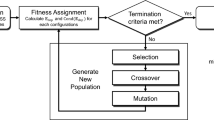Abstract
The use of liquid helium and neon as scintillators for neutrino detection is investigated. Several unique properties of these cryogens make them promising candidates for real-time solar neutrino spectroscopy: large ultraviolet scintillation yields from ionizing radiation, transparency to their own scintillation light, and low levels of radioactive impurities. When neutrinos scatter from electrons in liquid helium or neon, ultraviolet light is emitted. The ultraviolet scintillation light can be efficiently converted to the visible with wavelength shifting films. In this way the neutrino-electron scattering events can be detected by photomultiplier tubes at room temperature. We conclude that the solar neutrino flux from the p+p→e++d+ν e reaction could be characterized and monitored versus time using a 10 ton mass of liquid helium or neon as a scintillation target.
Similar content being viewed by others
REFERENCES
R. Davis, D. S. Harmer, and K. C. Hoffman, Phys. Rev. Lett. 20, 1205 (1968).
T. Bowles (for the SAGE Collaboration): Proceedings of the 4th International Solar Neutrino Conference, W. Hampel (ed.), Heidelberg, Germany (1997).
M. Cribier (for the GALLEX Collaboration), Nucl. Phys. B (Proc. Suppl.) 70, 284 (1999).
Y. Fukua et al., Phys. Rev. Lett. 77, 1683 (1996).
Kamiokande Collaboration: Phys. Rev. Lett. 77, 1683 (1996).
J. N. Bahcall, S. Basu, and M. H. Pinsonneault, Phys. Lett. B 433, 1 (1998).
R. E. Lanou, H. J. Maris, and G. M. Seidel, Phys. Rev. Lett. 58, 2498 (1987); S. R. Bandler, C. Enss, G. Goldhaber, R. E. Lanou, H. J. Maris, T. More, F. S. Porter, and G. M. Seidel, J. Low Temp. Phys. 93, 785 (1993).
A. de Bellefon for the HELLAZ collaboration, Nucl. Phys. B (Proc. Suppl.) 70, 386 (1999).
C. Arpesella, C. Broggini, and C. Cattadori, Astroparticle Physics 4, 333 (1996).
R. S. Raghavan, Phys. Rev. Lett. 78, 3618 (1997).
J. N. Bahcall, Neutrino Astrophysics, Chap. 8, Cambridge University Press, Cambridge, UK (1989).
Gioacchino Ranucci and Borexino Collaboration, Nucl. Phys. B (Proc. Suppl.) 70, 377 (1999).
M. Stockton, J. W. Keto, and W. A. Fitzsimmons, Phys. Rev. A 5, 372 (1972).
R. E. Packard, F. Reif, and C. M. Surko, Phys. Rev. Lett. 25, 1435 (1970).
C. M. Surko, R. E. Packard, G. J. Dick, and F. Reif, Phys. Rev. Lett. 24, 657 (1970).
H. A. Roberts and F. L. Hereford, Phys. Rev. A 7, 284 (1973).
S. Kubota, M. Hishida, M. Suzuki, and J. Ruan(Gen), Phys. Rev. B 20, 3486 (1979).
A. Hitachi, T. Takahashi, N. Nobutaka, K. Masuda, J. Kikuchi, and T. Doke, Phys. Rev. B 27, 5279 (1983).
K. Habicht, Ph.D. thesis, Technical University of Berlin, 1998 (unpublished).
J. S. Adams, Y. H. Kim, R. E. Lanou, H. J. Maris, and G. M. Seidel, J. Low Temp. Phys. 113, 1121 (1998).
J. M. Doyle and S. K. Lamoreaux, Europhys. Lett. 26, 253 (1994).
D. N. McKinsey, C. R. Brome, J. S. Butterworth, R. Golub, K. Habicht, P. R. Huffman, S. K. Lamoreaux, C. E. H. Mattoni, and J. M. Doyle, Nucl. Inst. and Meth. B 132, 351 (1997).
Carlo Mattoni, private communication. In addition to the long-time measurements described in Ref. 21, work in our laboratory has placed limits on the amount of blue light emitted by TPB after 20 ns.
T. Doke, K. Masuda, and E. Shibamura, Nucl. Inst. and Meth. A 291, 617 (1990).
D. N. McKinsey, C. R. Brome, J. S. Butterworth, S. N. Dzhosyuk, P. R. Huffman, C. E. H. Mattoni, J. M. Doyle, R. Golub, and K. Habicht, Phys. Rev. A 59, 200 (1999).
C. F. Chablowski, J. O. Jensen, D. R. Yarkony, and B. H. Lengsfield, III, J. Chem. Phys. 90, 2504 (1988).
B. Schneider and J. S. Cohen, J. Chem. Phys. 61, 3240 (1974).
T. Suemoto and H. Kanzaki, J. Phys. Soc. Jpn. 46, 1554 (1979).
The emissivity of organic substances can range from 0.1 to 0.9. See F. Pobell, Matter and Methods at Low Temperatures, Chap. 5, p. 84, Springer-Verlag, Berlin Heidelberg, Germany (1992).
I. M. Ward, Mechanical Properties of Solid Polymers, Chap. 12, Interscience, New York (1971).
J. Seguinot, T. Ypsilantis, and A. Zichichi, A Real Time Solar Neutrino Detector With Energy Determination, Fourth International Workshop on Neutrino Telescopes, p. 289 (1992).
F. T. Avignone, III, R. L. Brodzinski, J. C. Evans, Jr., W. K. Hensley, H. S. Miley, and J. H. Reeves, Phys. Rev. C 34, 666 (1986).
Alimonti et al., Nucl. Inst. and Meth. A 406, 411 (1998).
G. Jonkmans for the SNO collaboration, Nucl. Phys. B (Proc. Suppl.) 70, 329 (1999).
SNO internal report SNO-STR-93-042.
W. S. Dennis, E. Durbin, W. A. Fitzsimmons, O. Heybey, and G. K. Walters, Phys. Rev. Lett. 23, 1083 (1969).
C. J. Martoff, Science 237, 507 (1987).
B. Cabrera, L. M. Krauss, and F. Wilczek, Phys. Rev. Lett. 55, 25 (1985).
G. L. Cassiday, J. W. Keuffel, and J. A. Thompson, Phys. Rev. D 7, 2022 (1973).
A. Bertin, A. Vitale, and A. Placci, Phys. Rev. A 7, 2214 (1973).
J. N. Bahcall and P. I. Krastev, Phys. Rev. C 55, 929 (1996).
Author information
Authors and Affiliations
Rights and permissions
About this article
Cite this article
McKinsey, D.N., Doyle, J.M. Liquid Helium and Liquid Neon-Sensitive, Low Background Scintillation Media for the Detection of Low Energy Neutrinos. Journal of Low Temperature Physics 118, 153–165 (2000). https://doi.org/10.1023/A:1004690906370
Issue Date:
DOI: https://doi.org/10.1023/A:1004690906370




